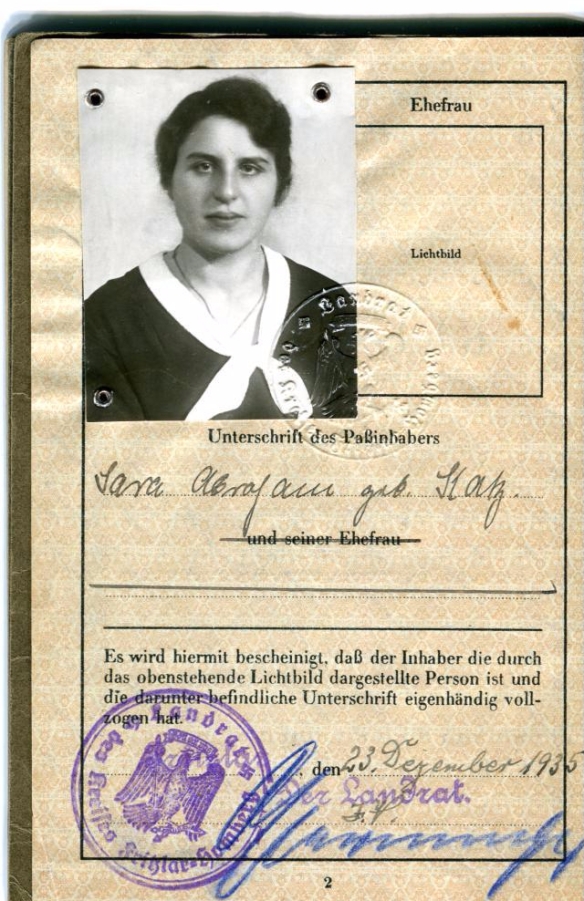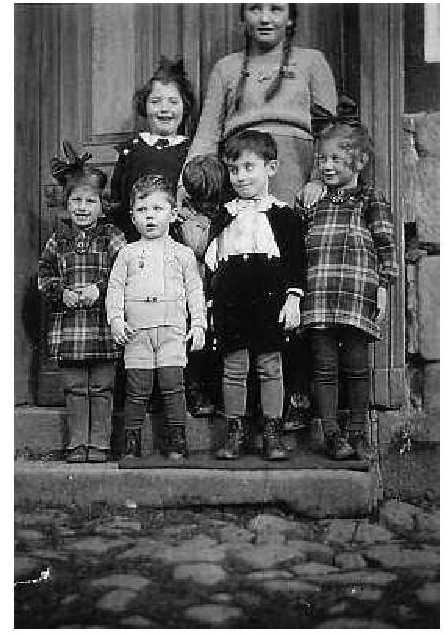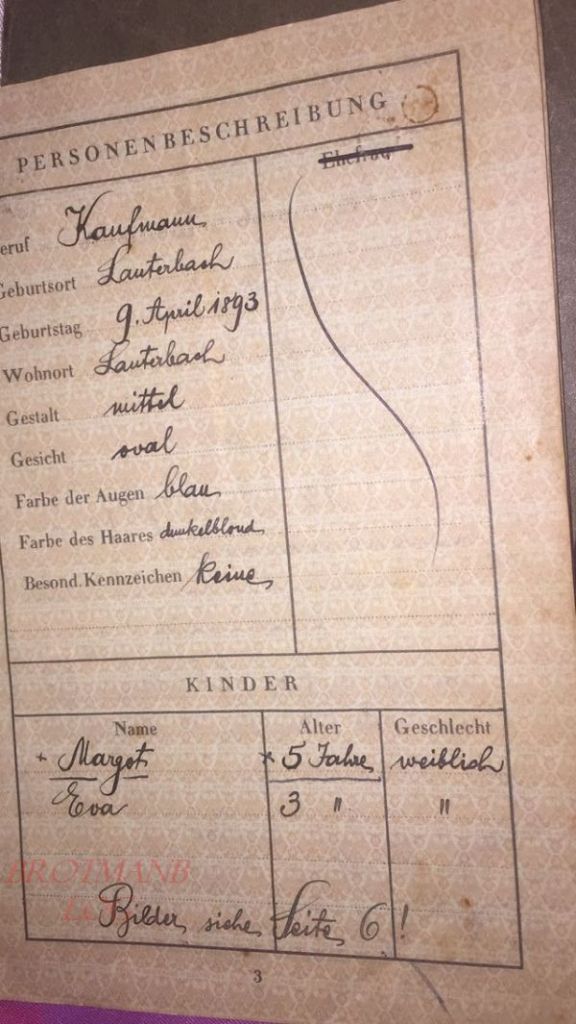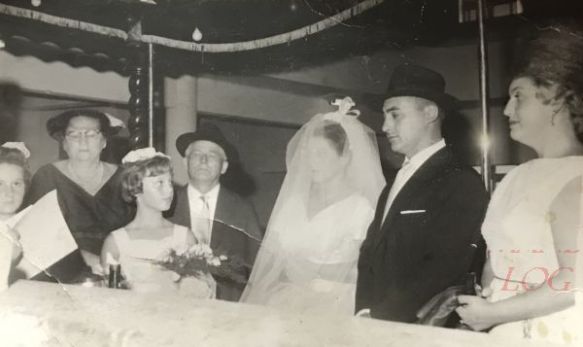Before I return to the remaining children of Jakob Katzenstein, I am tying up a few loose ends about some of the Katzenstein families I have already discussed. This post involves the family of Mali Katz.
Mali was the great-granddaughter of Rahel Katzenstein and Jacob Katz, the granddaughter of Moses Katz and Malchen Wetterhahn, and the daughter of Markus Katz and Minna “Nanny” Wallach. She was the sister of Maurice Katz and Senta Katz, both of whom had immigrated to the United States, Maurice in 1925 to Oklahoma, Senta in 1937 to New York. Senta was married to Julius Abraham(s), and they were the parents of Fred and Martin Abrahams, the two brothers with whom I have been corresponding.
But I knew very little about the third sibling, Mali. I knew that Mali had married Siegfried Baumann on April 17, 1930, in Jesberg. Siegfried was born in Lauterbach, Germany, in 1893. I knew from Martin, Mali’s nephew, that Mali and her family had been unable to get permission to immigrate to the United States and that they had ended up in Brazil, but Martin knew nothing more than that. And I could not find anything else.
There was, however, one tree on Ancestry that provided some more information, but without sources. It had Siegfried Baumann married to a woman named Maly with one daughter named Margot Baumann. Those were the only names revealed, and the only information attached to Siegfried, Maly (no birth name given) and Margot were their birth places as Germany and places of death as Porto Alegre, Brazil. There were no birth dates for Siegfried or Maly, but there were dates of death for Siegfried, Maly, and Margot. I wrote to the tree owner, but did not hear back.
By Googling “Margot Baumann Porto Alegre,” however, I found the Facebook page for SIBRA— Sociedade Israelita Brasileira de Cultura e Beneficência, or the Brazilian Society for Jewish Culture and Charity. On that page was a long post that detailed the eighty year the history of the organization, written by Grete Blumenthal Bejzman and posted by the rabbi for the SIBRA synagogue on their Facebook page on August 29, 2016. Siegfried Baumann and his two daughters Margot and Eva were all mentioned in this post.
According to Bejzman’s post, SIBRA was founded eighty years before, i.e., on August 29, 1936, to assist the German Jewish refugees who were arriving in Brazil. The society obtained a building with a hall for a synagogue and rooms for social and cultural meetings. SIBRA became a place of comfort for the new immigrants, a place where they could learn Portuguese and Brazilian culture, a place to pray and a place to receive assistance with finding work and homes, and a community of people who helped in times of illness or other emergencies. In this post, Siegfried Baumann is mentioned as a synagogue leader, and his daughters Margot and Eva are mentioned in the context of a trip to Ipanema organized by SIBRA.
From this Facebook post I learned that the Baumann family was very involved in SIBRA and the Porto Alegre Jewish community. I left a message on the SIBRA page and sent a message through their website, asking how I might contact members of the family, but I did not hear back. Perhaps the fact that I don’t know Portuguese made it hard for them to understand my inquiry, or perhaps they were being protective of the privacy of the family. But at least I had the names of the two daughters and their married names (Margot was identified as Margot Baumann Leventhal and Eva as Eva Baumann Dorfman) and could search for them on my own.
I decided to post a question to the LatAmSIG on JewishGen, asking for advice on how to contact the Baumann family. I received two very helpful responses, one pointing to a Geni page for Eva’s family and one from someone who was a good friend of Margot’s son and who gave me his email address and the names of his siblings. Based on this additional information, I also found several of Mali’s grandchildren on Facebook, and one of them, Margot’s daughter Iara, responded with great enthusiasm.
Iara has now shared with me not only information about her family, but also her grandparents’ passports and several family photographs. With her permission, I can now complete the story of Mali Katz Baumann and her family.
Mali and Siegfried lived in Lauterbach, Germany, where Margot was born on April 30, 1931, and Eva was born on September 24, 1933, according to Iara. Siegfried was in the leather business with his brother Max.
The Baumann family left Germany in 1936 and settled in Porto Alegre, Brazil. Porto Alegre is the capital of the state of Rio Grande do Sol, the state in Brazil where most of the German Jewish refugees came in the 1930s to escape Nazi Germany, according to Iara. Siegfried Baumann’s brother Max was already there when Siegfried, Mali, and their daughters arrived.
Here are the passports of Siegfried Baumann, Mali Katz Baumann, and their two young daughters showing their departure from Germany and their immigration to Brazil. It’s wonderful that Iara shared these with me because not only do they provide descriptions of Siegfried and Mali, there are also photographs of Mali, Margot, and Eva.
First, Siegfried’s passport, which also included the little girls:
Here is Mali’s passport:
UPDATE: Martin Abrahams, son of Senta Katz Abraham, sent me the images of his mother’s passport after seeing this post. Here is her photograph. The resemblance between Senta and her sister Mali is striking:

Martin also shared this photograph of the four cousins (plus two older cousins in the back row). In the front are Eva Baumann, Fred Abraham(s), Martin Abraham(s), and Margot Baumann before they all escaped from Germany.

Front row: Eva Baumann, Fred Abrahams, Martin Abrahams, Margot Baumann. Courtesy of Martin Abrahams
Iara told me that her grandparents Mali and Siegfried always held on to their Jewish identity and traditions after settling in Brazil. They were among the leaders of the SIBRA synagogue and celebrated Shabbat and all the Jewish holidays. Iara described her grandmother as strong and energetic and her grandfather as “too gentle.” They lived in the same building with their daughter Margot for their entire time in Porto Alegre. Iara told me that Mali’s brother Maurice/Moritz and his wife came to visit them in Brazil and that Mali often spoke with her sister Senta by telephone.
Their daughter Margot Baumann married Julio Leventhal, a business owner in Brazil, on March 27, 1960. Here is a photograph of Margot and Julio’s wedding:
Margo worked in a business importing and exporting leather until her children were born. Margot and Julio had three children, including my cousin Iara, her brother Luis David, and sister Liana.
Eva Baumann was a physiotherapist who worked in hospitals in Porto Alegre. She married Raul Dorfman, who taught at the University of Rio Grande do Sul, on February 28, 1962. They had two children, Mauro and Adriana.
Siegfried died on July 14, 1981, and Mali died on December 21, 1987. Eva died on May 8, 2001. Margot died on August 21, 2006, and her husband Julio died on December 20, 2015. They are all buried in the Jewish cemetery in Porto Alegre.
Mali Katz and Siegfried Bauman and their daughters Margot and Eva are survived by the five children of Margot and Eva and many grandchildren. Iara pointed out to me that the first names of her siblings, her first cousins, and herself spell out the name MALI (sometimes spelled Malli) (Mauro, Adriana, Luis/Liana, Iara). They all are determined to carry on the proud legacy that they have inherited from their grandmother Mali, their grandfather Siegfried, and their parents.
Iara also shared with me a number of photographs of Eva and Margot and their children and grandchildren, and with her permission I am posting two of them here.

Wedding of Iara Leventhal and Jaime Aronis with Julio Leventhal on the left and Margot Baumann Leventhal on the right Courtesy of Iara Leventhal
I feel very fortunate to have found Iara and to have learned so much more about her family—another family that escaped from Nazi Germany and was forced to start life over in a whole new country with a whole new language and culture. Another family that is evidence that Hitler did not prevail.












Amy, you have Googling down to a fine art! Congratulations on finding Iara who was so kind to share the photos, documents, and story with you. I especially liked the naming of the grandchildren.
LikeLiked by 2 people
Yes, so did I! I wonder if that was deliberate.
LikeLiked by 2 people
Even if it wasn’t, it sounds like the descendants may believe it could have been.
LikeLiked by 1 person
Yes, or the subconscious played a bit part in the selection of the names!
LikeLiked by 1 person
Amy, I found this fascinating in at least two ways. First, your search using Facebook and Google is hardcore. You inspire me to try harder, especially with Facebook. Second, you’ve brought “to life” a branch that seemed lifeless and covered it with leaves–the details of the lives of these family members. And then the photos! So impressed!
LikeLiked by 2 people
Thanks, Luanne! Facebook and Google are incredibly helpful for finding living descendants. The biggest breaks I’ve gotten often are from obituaries where survivors are listed, sometimes even identifying where they live. That is often how I find cousins—an obit, then Google and/or Facebook. The harder part is getting a response—though lately I’ve been lucky with that as well. Thanks so much for your kind words!
LikeLiked by 1 person
I am going to keep your method in mind!
LikeLiked by 1 person
Let me know if I can help!
LikeLiked by 1 person
You will be sorry you offered, I’m pretty sure ;).
LikeLiked by 1 person
I don’t think so!
LikeLiked by 1 person
You’d be a formidable private investigator if you ever decided to be Amy. I’m so glad that you’ve been able to uncover and document this branch of the family. That first photo is so lovely. Mali in particular has the cutest expression.
LikeLiked by 1 person
I love that photo also—so sweet and innocent, none of them ever expecting that their lives would be disrupted and that’s they’d all end up in different places as adults. Thanks, Su!
LikeLiked by 1 person
Fortunately they ended up in a safe place.
LikeLiked by 1 person
Yes, they created a new home in such a different place. It’s quite remarkable to me.
LikeLiked by 1 person
I agree. My family migrated to NZ from Scotland and that seemed huge for us, but we came to a very “British” place, where people speak English, drive on the same side of the road, eat pretty similar foods and share a cultural heritage.
LikeLiked by 1 person
Right—and that riding on the left side of the road really does create a cultural obstacle for those of us from the rest of the world!
LikeLiked by 1 person
Yes; we experience it in the number of road incidents where tourists lose concentration and crash their cars into oncoming traffic. I guess the same happens with Kiwi/Aussie/UK drivers in the rest of the world. 😦
LikeLiked by 1 person
I wonder how it evolved that the UK countries drove on the “wrong” side of the street.
LikeLiked by 1 person
Hehe. It seems that travelling on the left is actually older (something to do with the dominance of right-handedness and needing to access your sword on horseback). I found this explanation quite interesting https://www.worldstandards.eu/cars/driving-on-the-left/
LikeLiked by 1 person
That is fascinating! Thank you for sending me the link. The sword explanation makes a lot of sense, and it seems things only changed with good old Napoleon. I wonder whether there are any studies showing whether there is any advantage to right v left side driving, given that most people are right hand dominant. So interesting! But I still don’t think we will ever drive in a left-side country.
LikeLiked by 1 person
I know what you mean. I’m happy to let T drive whenever we’re in a right-hand drive country 🙂
LikeLiked by 1 person
And I am happy to let Harvey drive anywhere….
LikeLiked by 1 person
Hehe. I tend to let T drive because he’s a terrible passenger!
LikeLiked by 1 person
This was a happy ending in so many ways…and a new beginning too! So exciting to have connected with new cousins and discovered what happened to this branch. I loved all the pictures too.
LikeLiked by 1 person
Thanks, Sharon!
LikeLike
Researching your family takes you everywhere – doesn’t it?!!
LikeLiked by 1 person
Yes, it does! And it proves how interconnected we all are.
LikeLiked by 1 person
I am happy you made this connection, Amy. Sometimes ongoing persistence is richly rewarded. Other times the closure is delayed. Anyway this time you struck gold! I think Margot and Eva look very much like Mali when they were little girls.
LikeLiked by 1 person
Thanks, Emily. I enjoyed connecting with my Brazilian cousins.
LikeLiked by 1 person
Oh Amy, this is WONDERFUL! I have connected with a few cousins and am always so disappointed when I hear from them once and then I’m off the radar. Like others have said, I need to spend more time with Google and Facebook to try harder!
I love the first photo of the three children – I sure would love to know what Mali was looking at!
LikeLiked by 1 person
Some of mine come and go also, but finding them on Facebook does make a difference because then I do get to see what they are doing and some photos even if we aren’t in direct contact very often.
LikeLike
That’s a great point. The next time I “find” someone, I’m going to try to connect with them on Facebook. A few of the cousins I’ve found have started a Facebook page just for the few of us but we aren’t very active anymore.
LikeLiked by 1 person
Good luck! I hope you have success with it.
LikeLike
Pingback: Sisters and Cousins | Brotmanblog: A Family Journey
Pingback: Friday's Family History Finds | Empty Branches on the Family Tree
Beautiful pictures
Very interesting
Check out my latest
http://Www.mydisruptivelife.com
Please follow and share
Feedback please
LikeLike
Thank you.
LikeLiked by 1 person
Amazing
Check out my blog
http://Www.mydisruptivelife.com
Follow and share
Thank u
LikeLiked by 1 person
Thank you! I will check out your blog.
LikeLike